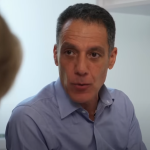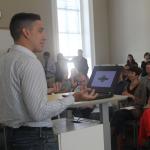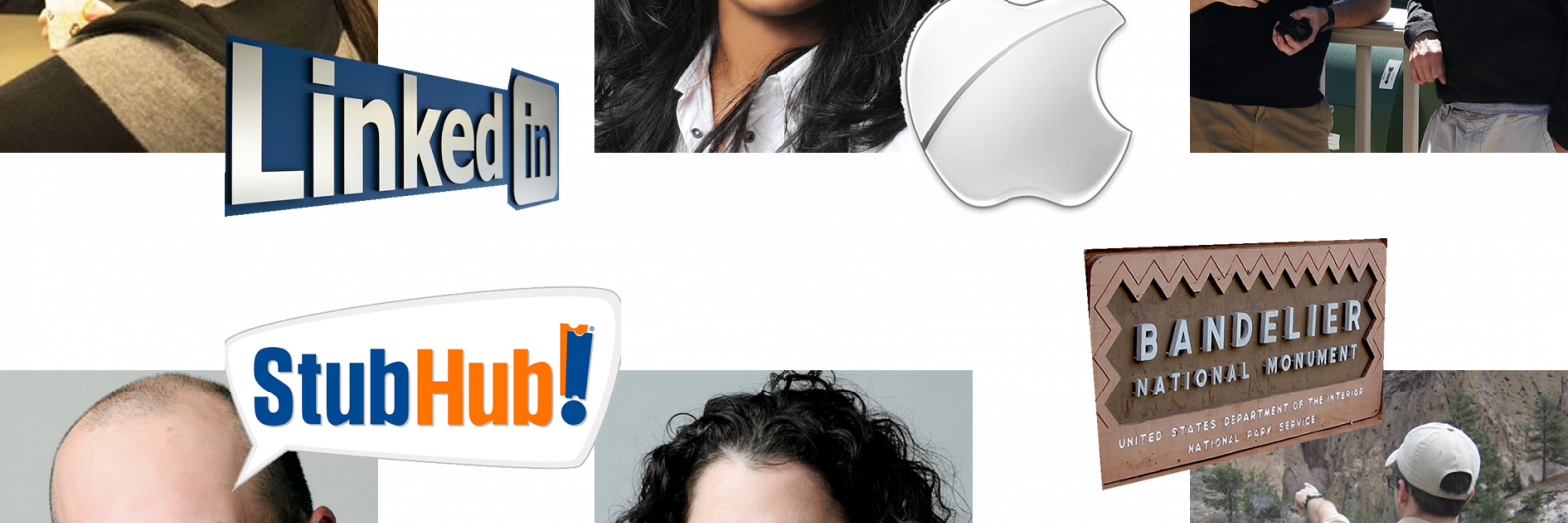This week, most of the students from the MIMS class of 2014 are finishing up summer internships and preparing to return to South Hall for the second year of their master’s program.
Students spent the summer at a wide range of companies, including Apple, Ernst & Young, Google, LinkedIn, Salesforce, Sony Network Entertainment, StubHub, Twitter, YouTube, and Zoosk. They worked in fields like big data analytics, business intelligence, information security, information technology risk transformation, product management, software engineering, UI design, user experience design, user experience research, and web development.
Several students were able to intern at non-profit organizations with support from the I School’s Non-Profit Internship Grant.
We spoke with seven MIMS students from the class of 2014 about what they’ve been doing this summer, how their first year’s classes prepared them for their internships, and what they’re planning for their second year and beyond.
Sandra Yuen Helsley
Web Developer
LinkedIn
Sandra Helsley just finished twelve weeks as a web developer on the team that supports LinkedIn’s 300+ Influencers. She worked with two designers and two other web developers on a new version of the editor tool that influencers use to write their posts; she also added a few smaller features which are visible from the article pages.
The summer as a web developer has been a detour from Sandra’s background in HCI research. Although she plans to return to user experience research, she took the web development internship to gain experience working with code in a real-world environment. “I think doing so has ultimately made me a stronger, more well-rounded researcher,” she said.
Sandra found the course Info 253. Web Architecture, which she took last fall, especially helpful for her internship. Info 247. Information Visualization and Presentation and Info 213. User Interface Design and Development also gave her valuable design experience and web coding skills.
Her number one resource during the interview process was classmate Gilbert Hernandez (MIMS ’13), who was a LinkedIn intern last summer. “He gave me some interviewing tips and assured me that the company and culture is great,” said Sandra. Gilbert joined LinkedIn full-time a few months ago.
Sandra wrote about her internship experience in the LinkedIn blog: “The Best Perk of Interning at LinkedIn: Free Knowledge.” (She also participated in the 2013 LinkedIn intern video, flashmobbing the company’s all-hands meeting.)
LinkedIn has already offered Sandra a full-time web development position upon graduation.
Ryan Baker & Ignacio Pérez
Pop Up Archive
Ryan Baker and Ignacio Pérez are interning at Pop Up Archive, a start-up founded by I School alumnae Anne Wootton and Bailey Smith (MIMS ’12) based on their final project. The two are working on developing the Pop Up Archive application, which is currently in beta release.
Although Ignacio has an extensive programming background, this is Ryan’s first venture into software development — and for both of them, this is their first experience at a start-up.
The start-up environment has been the most valuable part of the internship for Ignacio; he was looking for something completely different from his background in the banking and airline industries. “We’ve had the opportunity to see how companies like this start growing,” he explained; “It's been a really great experience.” The School’s Non-Profit Internship Grant has helped sponsor their internship.
Ryan has a long history in the music business and as an amateur audio archivist, so the world of independent radio producers has not been a huge adjustment for him — but he has relished the opportunity to work in software development for the first time, and has enjoyed learning new web development technologies like AngularJS and Ruby on Rails. “This is one of the reasons I came to the I School,” he explained. “This summer has given me a lot more confidence in my abilities to do this kind of programming.”
Both Ryan and Ignacio have found their first-year coursework valuable in their internship. Info 202. Information Organization and Retrieval has been especially relevant to the organizational challenges of the Pop Up Archive. “A lot of Info 202 involved understanding how people categorize things differently,” said Ryan. “It’s important to anticipate how people are going to use the archive, and structure it in a way that’s designed to meet their goals.”
Info 290. Innovation and Information gave them useful skills for building a start-up. “The course really provided the right tools for designing and organizing the small details of running a business,” said Ignacio. And Info 205. Information Law and Policy gave them a useful framework for thinking about user privacy and user interactions from a policy perspective.
Both Ryan & Ignacio are looking forward to using their new skills and experiences in their MIMS final projects during the next year — although neither admits to having decided yet exactly what those projects will be.
Priya Iyer
Customer Database Intern
Apple
Priya Iyer can’t really reveal much about her summer internship at Apple, but she does admit she has been working with Apple’s customer database, monitoring data quality and analyzing and improving the data. Her focus at the I School has been data analysis, data mining, and business intelligence, and she has been able to apply those skills this summer.
“This internship has exposed me to how data actually works in industry,” she said. “I could apply a lot of concepts from Info 290. Data Mining and Analytics with Jim Blomo and Info 290. Analyzing Big Data with Twitter with Marti Hearst.” The most important class for her, though, was Info 247. Information Visualization and Presentation, since a lot of her work has involved visualizing massive datasets and analyses using the course’s concepts and techniques.
In additional to honing her data analysis skills, the summer’s internship has helped Priya crystalize her career goals, or “completely changed my outlook towards work,” as she recently tweeted. In the past, she had felt torn between her interests in technology and business. “Working here and talking to a lot of people has helped me decide that I want to go into decision-support, where I apply my data-analysis knowledge and skills to analyze data for a specific business purpose,” she said. That newfound clarity has also helped her in selecting courses for her second year in the MIMS program.
“Overall, this internship at Apple has been a great morale boost, and a great career boost,” said Priya.
Lisa Jervis
Progressive Technology Project
Researcher
Lisa Jervis spent the summer working with the Progressive Technology Project, a national non-profit that helps community organizations achieve their goals more effectively and efficiently by integrating technology into their work.
Lisa conducted a qualitative research project on the database practices of community organizers, to understand the database challenges, barriers, and best practices faced by really small community organizing groups. Her summer project was supported by the I School’s Non-Profit Internship Grant.
Lisa had worked with PTP before starting the MIMS program; the idea for the research project initially arose in last fall’s course Info 272. Qualitative Research Methods for Information Systems and Management, and she approached PTP to suggest the summer internship.
Lisa credited the course Info 203. Social and Organizational Issues of Information with preparing her for this summer’s work practice studies. “The concepts from 203 have been invaluable to me in understanding what’s happening in the organizations I’m studying,” she said. Info 202. Information Organization and Retrieval also provided a useful framework as she thinks about database practices.
Overall, the summer has been valuable to Lisa in clarifying her career goals; after graduation, she plans to consult with small community-organizing groups about their technology and operations strategies, including databases, distance collaboration tools, process improvements, and infrastructure. The summer internship has reinforced the value of that career choice. “They really need this expertise in that sector!” she said.
It has also prepared her for the upcoming school year. “This research has really shown me a lot about what I want to get out of my next semesters at the I School,” Lisa said. She’s looking forward to taking Info 257. Database Management and Info 253. Web Architecture, for starters. “I'm seeing more specifically where the gaps in my knowledge match up with the needs in the field, and where I need to fill in the gaps in my knowledge.”
Corey Hyllested
Data Scientist Intern
StubHub
Corey Hyllested spent the summer building a music recommendation system for StubHub, to recommend upcoming concerts or events in your area, based on your preferences or previous events you attended.
Although he came to the I School with a lot of technical experience, this was Corey’s first job that emphasized user experience and information policy. “I wanted to use this opportunity to try something that I hadn't done before,” he explained.
When interviewing for the internship, Corey especially appreciated input and advice from classmates Rui Dai (MIMS ’13), who interned at StubHub last summer, and Aijia Yan (MIMS ’13), who started a career position at StubHub this year.
In his internship, Corey has found himself using skills from a number of his first-year MIMS courses, including Info 202. Information Organization and Retrieval, Info 205. Information Law and Policy, and Info 290. Data Mining and Analytics in Intelligent Business Services. He was especially guided by the case studies from Info 216. Computer-Mediated Communication, including cautionary tales of companies that made bad decisions about customer interactions and had them blow up in their faces. “The great thing about the coursework here is that has been far more pragmatic and not just abstract theory,” he said.
His summer project has been successful so far; StubHub is hoping to roll out the system to its website and mobile app soon, possibly as early as September, and is trying to recruit Corey for a career position when he graduates in May 2014. “What this has really showed me is that I can do this,” he said. This has encouraged him to move out of his comfort zone during the second year of the MIMS program, and focus on learning new skills — management, product & project management, and other “softer” skills.
Eric Zan
Technology & Interpretation Park Ranger
Bandelier National Monument, New Mexico
Eric Zan has always loved America’s national parks, but it had never occurred to him that he could combine that passion with his computer science experience.
When Eric arrived at the I School last fall, he met several other park enthusiasts, including classmate Colin MacArthur, a former park ranger. He found himself working on a variety of park-based research and projects, including a class project exploring the experience of visitors to the California state park system in Info 214. Needs and Usability Assessment.
“Your classmates are the number one capital in the I School, to help you discover and follow your interests,” said Eric. Working with his classmates helped spark his interest in using information technology to engage and inform park visitors in new and innovative ways.
His classmates also helped him build connections. Colin put Eric in touch with the Head of Interpretation at Bandelier National Monument in New Mexico, where Eric has spent his summer as park ranger for technology and interpretation.
“In general, the mission of the park system is combination of resource management and interpretation,” Eric explained; ‘resource management’ involves protecting and preserving the park’s resources, both physical and cultural, while ‘interpretation’ includes the park’s visitor services, which educate, inform, and engage park visitors.
Eric’s summer internship has been an interesting combination of tasks. Half his time has been as a front-line park ranger, staffing the park’s visitor center, leading guided walks, and interacting with park visitors. In the other half, he has provided technical assistance to park staff and worked to develop effective approaches for designing products for visitors.
Parks everywhere are experimenting with ways to use new information technologies to engage visitors. Bandelier’s main resources are cultural; the site protects the homes and artifacts of the Ancestral Pueblo people, who lived there from approximately 1150 CE to 1550 CE.
“How can we use data to tell the park’s stories?” asks Eric. The park has begun taking high-resolution radar scans of the site’s cliff dwellings, both caves and houses, and Eric is thinking about creative ways for visitors to view and interact with that data, to connect the site’s geography with its history. “I'm trying to translate my understanding of the visitors into designing products and visual displays using principles that I learned at the I School,” he says.
His work with the park’s visitors provides him with valuable perspective for designing interpretive experiences. He is developing a first-hand knowledge of the visitors’ needs, expectations, and “pain points,” as well as the challenges faced by the park rangers. In a sense, he feels like he’s using the ethnographic approach to research that professor Jenna Burrell taught in Info 203. Social and Organizational Issues of Information.
After the summer internship, “I see the power of technology to inspire visitors differently and connect with them emotionally,” Eric says; but he also has a new appreciation for the challenges. “It’s been a new experience to have an inside view, where previously I only saw it from the outside,” he says. Overall, that experience has re-energized his interest in using technology in parks.
For more information and statistics about MIMS students’ summer internships, see the results of the 2013 MIMS Internship Survey 2013 (PDF).








